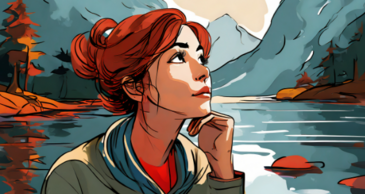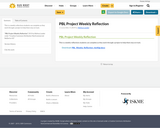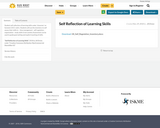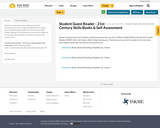
Making a birthday party plan using a chart and brainstorming
-games you can play, food to serve, decorations
-how other countries celebrate
- Subject:
- Social Studies
- Material Type:
- Activity/Lab
- Date Added:
- 09/20/2018

This is a collection of resources to teach Reflective Thinking including setting challenges, plan-do-review, inviting feedback and sharing learning.

Making a birthday party plan using a chart and brainstorming
-games you can play, food to serve, decorations
-how other countries celebrate

This is a template students can use to create a plan of action for a project.

This is a weekly reflections students can complete as they work through a project to help them stay on track.

The following is an example of a template for a weekly reflection students could use if they were working on PBL or Genius Hour, or any project.

Early in the year, have the students fill in the questionnaire and begin to think of activities they would enjoy participating in. This will help the teacher make decisions regarding class activities and individual time for students. Spend some time in a lab allowing students to find activities that will work on areas identified in their FITT plan (for example, if they want to improve their flexibility on the sit and reach by 10 cm, have them research exercises that increase flexibility). Students will add these exercises to their portfolio. Allow students time to work on their FITT plans during designated times throughout the year. Students can track results through FItstats fitness tests performed 5 times per year.

This is a variety of ideas for ways students can share their learning.

From the Wabisabi blog by Lee Wantanabe-Crockett
15 reflection questions for learners of all ages. These are very useful for professional development as well as for students.

Following the included links, and after viewing all of the sites, choose 3 of the artists and their works above to answer the following questions:
A brief description of the artist and his life: date of birth and death, where he lived (what country was he from), his occupation (job), the subject (what he was painting/sculpting) of his artwork
When the artwork was created
Describe what the piece of artwork looks like: include colors, textures, medium (what was used to create it: type of paint, sculpture, photograph…)
Write the quote from beneath each picture
Do you like the artwork? Why or why not?
What does the artwork make you think about? What does it make you feel?

The following are a set of daily checklists students can use to reflect on each individual SECRET skill. The log has the students rate themselves on the sub skills of the big skill as well as set a goal for what they need to focus on to improve the next day.

This is a collection of reflections and other materials that will be useful for report card and parent teacher interviews to explain the SECRET skills as well as reflect on progress to date.

This worksheet will help your group set SMART goals.

SMART Goals are: specific, measurable, attainable, realistic and time bound. This worksheet will help your student set and achieve SMART Goals.

Let your students set their own SMART goals, keeping them accountable and determined, with achievable outcomes.

Make learning come to life! Participating in hands-on STEAM (Science, Technology, Engineering, Art, Math) Challenges can provide students with opportunities to develop new skills and understandings related to their preferred life/career choices. These challenges help students build 21st Century Skills while exploring potential occupations of interest. Students will be able to reflect on what areas best fit their interest, skills, values, etc. as they work to create the life they want to live.

This is a self-assessment tool that is designed for administrators to use to reflect on their schools’ success in supporting smooth transitions for students. We know that schools are generally welcoming to students who arrive in September or at other expected transition times, but sometimes in the hectic world of schools the important work to welcome, orient and support new students is overlooked. Many students who transfer at unexpected times are in challenging circumstances and need transition support. I encourage you to support your school administrators in establishing strong communication and relationship protocols that support smooth student transitions. See the preamble and the rubric itself for further details.

This activity makes students aware of how well they are self-managing or regulating.
It ASKS : "Today when you are working, there will be a clock or timer on the SMARTBoard. At random intervals, you will hear a beep or a bell. When you hear the sound, reflect on your behaviour. Are you self-managing?"
Students complete the chart attached to measure their growth and ability to self-manage or regulate.

Student self reflection of learning skills under 'character' on Sunwest 21CC rubric.
Students will use the inventory to self assess their skills in:
- time management
- self regulation
- organization
- study skills & test anxiety
Assessment can be used to guide goal setting and explicit teaching of skills.

In this lesson, students consider the value of setting goals for themselves and for their community, thinking critically about the idea of defining community and shared interests and concerns. This is an introduction to the concepts that underlie the Millennium Development Goals.

I decided to do this activity as a fun way to get my students engaged in the ever daunting physics unit in science 10. This activity was very easy to set up and I already had access to most of the materials at school. The basic idea of this was to create a launcher or sling shot with the materials you are given that will launch your army man the farthest. I gave each group 3 tries as sometime the launch didn’t go as planned. We marked the farthest launch and I had a prize for the winning group.

Student's prepared and read a children's book that demonstrate one of the 7 Habits of Highly Effective People (Grit, Growth Mindset, SECRET skills, 21st Century Skills, Problem Solving, etc). The book was chosen for the student for the 1st round, then students chose their own book for the second round.